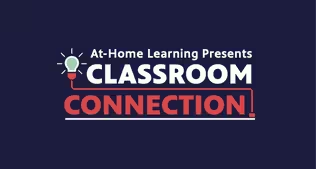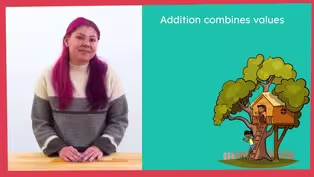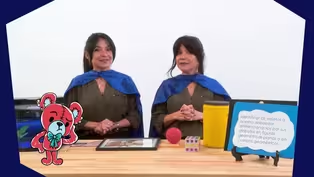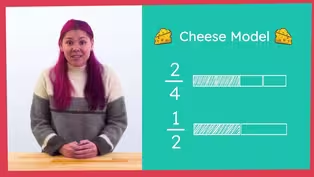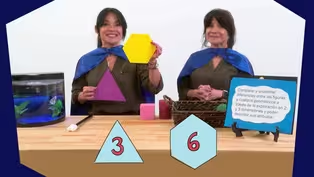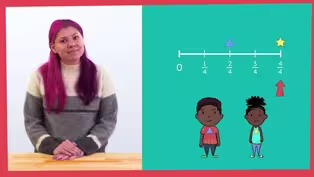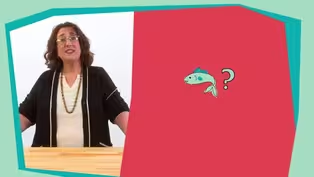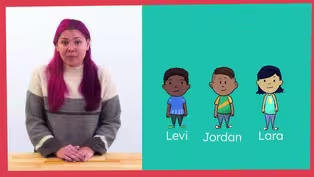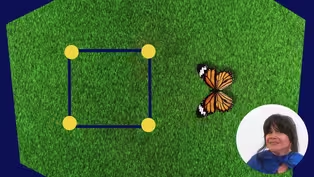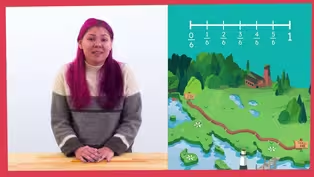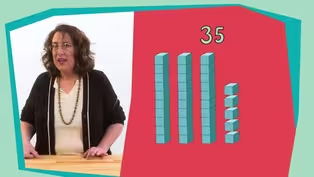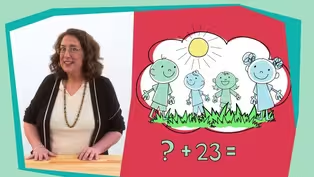
Episode 10 | Math Lessons
3/1/2021 | 28m 46sVideo has Closed Captions
Math lessons for early learners, led by NC teachers.
The first lesson (aimed at 3rd graders) helps students make sense of multiplication, with counting and repeated addition strategies. The second lesson (aimed at PreK-K learners) helps students learn how to count to 100. Classroom Connection is your At-Home Learning companion where children love to learn. All lessons are led by NC educators.
Problems playing video? | Closed Captioning Feedback
Problems playing video? | Closed Captioning Feedback
At-Home Learning Presents: Classroom Connection is a local public television program presented by PBS NC

Episode 10 | Math Lessons
3/1/2021 | 28m 46sVideo has Closed Captions
The first lesson (aimed at 3rd graders) helps students make sense of multiplication, with counting and repeated addition strategies. The second lesson (aimed at PreK-K learners) helps students learn how to count to 100. Classroom Connection is your At-Home Learning companion where children love to learn. All lessons are led by NC educators.
Problems playing video? | Closed Captioning Feedback
How to Watch At-Home Learning Presents: Classroom Connection
At-Home Learning Presents: Classroom Connection is available to stream on pbs.org and the free PBS App, available on iPhone, Apple TV, Android TV, Android smartphones, Amazon Fire TV, Amazon Fire Tablet, Roku, Samsung Smart TV, and Vizio.
Providing Support for PBS.org
Learn Moreabout PBS online sponsorshipMore from This Collection
Math lessons for early learners, led by NC teachers.
Video has Closed Captions
Math lessons for early learners, led by NC teachers. (28m 46s)
Video has Closed Captions
Math lessons for early learners, led by NC teachers. (28m 46s)
Video has Closed Captions
Math lessons for early learners, led by NC teachers. (28m 46s)
Video has Closed Captions
Math lessons for early learners, led by NC teachers. (28m 46s)
Video has Closed Captions
Math lessons for early learners, led by NC teachers. (28m 46s)
Video has Closed Captions
Math lessons for early learners, led by NC teachers. (28m 46s)
Video has Closed Captions
Math lessons for early learners, led by NC teachers. (28m 46s)
Video has Closed Captions
Math lessons for early learners, led by NC teachers. (28m 46s)
Video has Closed Captions
Math lessons for early learners, led by NC teachers. (28m 45s)
Video has Closed Captions
Math lessons for early learners, led by NC teachers. (28m 46s)
Video has Closed Captions
Math lessons for early learners, led by NC teachers. (28m 45s)
Video has Closed Captions
Math lessons for early learners, led by NC teachers. (28m 46s)
Providing Support for PBS.org
Learn Moreabout PBS online sponsorship[cheerful upbeat music] ♪ - Hey everyone.
I'm really glad you're here today because I need your help.
I'm tryna write this song but I keep getting stuck.
Here let me show you.
All right.
Here it goes.
♪ One, two, three, four ♪ ♪ Put on my shoes and walk out the door ♪ ♪ I said five, six, seven, eight ♪ ♪ The sun is shining and I'm feeling... ♪ Fine?
That doesn't rhyme.
Hold on, hold on, hold on.
♪ Five, six, seven, eight ♪ ♪ The sun is shining and I'm feeling... ♪ good.
No, no, that's not right either.
What's a word that rhymes with eight and mean super good.
Wait, hold on.
I think I heard something.
Not say that again.
Great.
Yes, that's it.
That's it.
♪ Five, six, seven, eight ♪ ♪ The sun is shining and I'm feeling great ♪ Wow.
Whew.
Thank goodness you're here or I would have never finished asked that song.
It looks like I could use some more practice with my reading and my numbers.
You wanna practice too?
Okay.
Let's do it together.
Starting now.
- Hello friends.
My name is Diane.
I'm so happy to see you.
Today, we're going to be talking about how to represent things that come in groups.
I just got back from one of those big superstores where you can buy everything you need, groceries, clothes, school supplies, all at the same store.
Here's what I bought today.
Some juice boxes, snack cakes, cracker packs, packages of nuts, glue sticks, socks, markers, and batteries.
What do you notice about the way they are all packaged?
What Was that?
Yeah.
That's right.
All of these items are packaged in groups.
I made a list of some more things that come in groups.
Wanna take a look?
It was pretty cool we got eyes that come in pairs so that's two, we've got three angles on a triangle, we've got six legs on an insect, got seven days in a week, and we've got 10 fingers.
This has me thinking about math problems that have equal groups.
Wanna help me solve some?
Great, thank you.
Let's start with this pair of socks.
One pair has two socks.
I can represent it with pictures, words, like one group of two, or with a number sentence to say one times two.
What does the one represent?
Exactly.
The number of groups.
And what does the two represent?
For sure.
The number in each group.
And let's look at that symbol in the middle what does that represent?
You whispered to me.
Yeah, the multiplication equation.
We can represent equal group problems with a multiplication symbol.
So let's think about it.
What if we had two pairs of socks how would we represent that?
We could say two groups of two, or two times two.
How can I find the total number of socks?
Yeah, I can count by twos.
We've got two, four.
And what about four pairs of socks?
Exactly.
We could have four groups of two or four times two.
So how many altogether?
Count with me.
Two, four, six, eight.
Now how about six pairs of socks?
You got it.
Six groups of two or six times two.
So how many altogether?
One more time count with me.
Two, four, six, eight, 10, 12.
Oh, I see but we got another one here we go.
What about 10 pairs of socks?
We got 10 groups of two or 10 times two.
Try this one on your own.
What did you get?
What was that?
Great job.
Yes, 10 times two does equal 20.
Mmh.
I wonder what else we could count in groups.
Ah, these juice boxes are packaged in groups of 10.
How many groups of boxes do we have?
Yes, exactly.
We have two groups of juice boxes.
So how many are in each group?
Yes.
There are 10 juice boxes in each group.
How can we figure out how many total juice boxes we have here?
Hm.
We could count by ones, but that might take awhile.
Do you think that there's a better way?
Oh, I heard someone saying count by tens.
That's a great idea.
Let's try that out.
So count by tens with me.
10 juice boxes, 20 juice boxes.
Excellent.
There are 20 juice boxes.
Now let's think about how could we represent our counting.
I'll give you a moment to think.
Right.
We could write two groups of 10 or two times 10.
What does the number two represent?
Say it with me folks.
Right.
The number of groups.
What about the number 10?
Exactly the number of juice boxes in each group.
And what about the 20?
Yes, we have 20 juice boxes all together.
So now what if I had three groups of juice boxes?
Three times 10 equals?
Count with me.
10, 20, 30.
What about four groups of 10?
10, 20, 30, 40.
What about six groups of 10?
10, 20, 30, 40, 50, 60.
All right, here we go.
10 groups of 10, 10, 20, 30, 40, 50, 60, 70, 80, 90, 100.
If we were to count groups of batteries what would we count by?
Yes.
Fours.
What about these box of crackers?
Yes.
Sixes.
What about the markers?
Exactly tens.
What about the cupcakes?
Eights.
Awesome job mathematicians.
Let's talk about a word that will show up during our time together.
We're going to be talking today about the word factor.
What we want to know is that when we're talking about factors, we're talking specifically about multiplication.
So with that being said, factors, if we're defining them, are two numbers multiplied together.
A lot of times when we're writing a number sentence when we're talking about multiplication, you'll see blank times blank.
That looks more like a plus so we're gonna make sure that we know that it's multiplication.
These two blanks would be where we put our factors.
So then what do these mean?
It's a great question.
One of them is going to be talking about the number of groups.
That is going to be 10 packs of pencils or we're going to be talking about three packs of crackers.
Whatever the case may be it's that number of groups that we have.
The second factor, that we're talking about is going to be the number in each group.
When we talk about the number in each group how many pencils were in those packs?
Was it five?
Was it 10?
Whatever the case may be it's however many are in the group.
The biggest thing when we're talking about factors is that we are going to be looking at equal groups.
So let's look down at my train cars.
You say, oh, I see three train cars So I've got three groups.
Now what about the number in each group?
What do you notice here?
Right.
They're unequal.
That would be an issue if we're trying to figure out a factor because the number in each group is unequal.
So now looking at this.
How are we going to make this equal?
What would you do?
I know for me, I would definitely have one of these people where there's three in the train car, come over here to hang out with this person.
Then, I've got two people in this train car, two people in this train car, and two people in this train car.
So my two factors for this are going to be three, and two.
Three train cars, and two people.
Understanding factors is so important when you're learning about equal groups.
Awesome job mathematicians.
Thanks for helping me think about things that come in groups.
We learned that we can represent equal groups with pictures numbers, and the multiplication symbol.
You also helped me find the total number of items with counting strategies.
Great job.
I'm going to go put up these groceries but I wonder what else I'll find that come in groups.
Maybe you could look around your house to see what comes in groups.
Join me next time to explore more multiplication strategies.
Bye y'all.
- I have so many friends who are artist.
They are such amazing people.
Check out this video.
Some artists who really inspire you.
- Hi, we are a string quartet.
Four people who play music together.
Just like we can say the same thing at the same time we can play the same thing in unison like this Beethoven.
[violin music] Here's another famous unison by Beethoven.
[violin music] We can even play a different kind of unison where the rhythm is the same but the harmony is dissonant.
Like this.
[violin music] - Or one of us can play the melody - while the rest of us play something else.
Like this.
[violin music] - Or two of us can play one thing, - while the two of us play something else.
[violin music] ♪ And now ♪ ♪ And now ♪ ♪ And now ♪ ♪ And now ♪ Now we'd like to play a whole piece by Beethoven.
- So listen up - concentrate - and enjoy.
[violin music] - Did you know the average yawn last six seconds?
One, two, three, four, five, six.
Next time you yawn count see how long it last.
But you won't be on it any anytime soon 'cause we have a super cool math lesson for you.
This'll help count down those seconds.
- Good morning super learners.
I'm Ms. M. I'm so glad you're joining me.
Are you ready for a math adventure today?
Well, let's get started with the song.
♪ Hello super learners how are you ♪ ♪ Hello super learners how are you ♪ ♪ I'm so glad you're here today ♪ ♪ And I hope you feel the same ♪ ♪ Hello super learners how are you ♪ How are you today?
I feel great today and I really hope you do too.
Let's get started with some math power warmups.
Counting up to 20.
Are you ready?
Here we go.
♪ One, two, three, four, five, six, seven ♪ ♪ eight, nine, 10 ♪ ♪ 11, 12, 13, 14, 15 ♪ ♪ 16, 17, 18 ♪ ♪ 19, 20 ♪ ♪ That was fun ♪ Awesome, awesome sauce super learners.
Let's count up to 21 more time and this time we're gonna snap count.
One, two, three, four, five, six, seven, eight, nine, 10.
Let's keep going.
11, 12, 13, 14, 15, 16, 17, 18, 19, 20.
Yes, super learners are the best.
I'm getting warmed up.
Are you?
How about one more time counting to 20 but this time in Spanish.
[sings in Spanish] 20.
Amazing super learners.
Now we've count it to 20 in three different ways.
And it's time to name our colors.
Let's review our colors.
Rojo, red, naranjo, orange, amarillo, yellow, verde, green, azul, blue, morado, purple, cafe, brown, negro, black, blanco, white, and gris, gray.
Look for these colors in the world today.
One more warmup.
Here we go.
Let's play the shape game.
You will see a shape and then you will say its name.
cuadrado, square, circule, circle, triangulo, triangle, rectangulo, rectangle, rhombo, rhombus, trapezoe, trapezoid, hexagono, hexagon, cubo, cube.
cono, cone, cilindro, cylinder, el sefera, sphere.
All warmed up?
Then it's time for... ♪ Our math mission of the day ♪ Let's check with Sparkles the fish to see what our math mission is today.
Dear super learners, your mission today is... become super counters.
Count to 100 in two different ways.
So today we will count to 100 in two ways.
Well, super liners I know we can do this mission.
Caps on.
Math power up let's go.
Here is a 100 chart.
This math tool can help us accomplish our math mission.
Let's start by counting all the way to 100 by ones.
That means he will say each number and order all the way to 100.
Ready?
Set?
Math power up.
One, two, three, four, five, six seven, eight, nine, 10, 11, 12, 13, 14, 15, 16, 17, 18, 19, 20 21 22, 23, 24, 25, 26, 27, 28, 29, 30 31 32 33 34 35 36 37 38 39 40 41 42 43, 44, 45, 46, 47, 48, 49 50 51 52 53 54 55 56 57, 58, 59, 60 61 62 63 64 65 66 67 68 69, 70 71 72, 73, 74, 75, 76, 77, 78, 79 80 81 82, 83, 84, 85, 86, 87, 88, 89 90 91 92 93, 94, 95 96, 97, 98, 99, 100!
Huh.
Do you hear that?
Wow, amazing super learners.
We just counted to 100.
One way.
We are halfway through our mission.
Mmh.
I wonder what another way to account to 100 days is?
But first it's time for our math movement break.
Let's exercise our numbers counting down from 10 for inspiration.
Are you ready to move your body to each number?
Let's go.
Math power up.
10 twists, one, two, three, four, five, six, seven, eight nine, 10.
Nine hops, one, two, three, four, five six, seven, eight, nine.
Eight arm circles, one, two, three, four, five, six, seven, eight.
Seven, knee bends, one, two, three, four, five, six, seven.
Six arm stretches, one, two, three, four, five, six.
Five knee raises, one, two, three, four, five.
Four side bends, one, two, three, four.
Three toe raises, one, two, three.
Or elevates.
Two head nods, one, two.
And one big jump, one.
That was fun counting down from 10, but we are running out of time.
Can we think of a second way to count to 100?
Oh, that's it.
We can count to 100 by tens.
Look at the chart.
At the end of each row is a 10th.
If we count by 10, we can accomplish our mission on time.
Let's do it super learners.
10, 20, 30, 40, 50, 60, 70, 80, 90, 100!
Wait, we did it.
We counted to 100 by tens.
Let's check back with Sparkles the fish.
Huh!
Mission complete.
We counted to 100 in two ways.
Congratulations super learners.
You used your math powers and completed the mission.
What is it time to do?
Let's review.
We can count by ones and by tens to get all the way to 100.
We know that when we count, we have to count in the right order.
Practice counting today.
You can share your math power by showing it to someone.
Thank you super learners for going on a math mission with me today.
Sparkles, thanks you too.
Remember, you have the power to be super at math.
Adios bye math power out.
- Hey everybody.
I was just thinking today about what it means to be a hero.
There are so many different ways to be a hero.
Our healthcare providers can be heroes, our teachers can be heroes.
There are some great leaders in our community helping to protect us, helping us feel seen, heard, and understood.
Those are all great types of heroes but sometimes you can be a hero just by lending a helping hand or listening to someone that needs to talk.
Our parents, grandparents, or a trusted adult can be our heroes.
Our sisters and brothers can be heroes.
Can you think of one person in your life that you consider to be a hero.
My hero, well, that's my little sister.
She is always there for me.
And you know what, I bet you can be someone's hero too.
Never stop learning, never stop listening, and take care of each other.
[cheerful upbeat music] ♪


- Home and How To

Hit the road in a classic car for a tour through Great Britain with two antiques experts.












Support for PBS provided by:
At-Home Learning Presents: Classroom Connection is a local public television program presented by PBS NC
